YouTube Marketing: Knowledge Base #
Types of YouTube Ads: #
There are 4 main types of YouTube Ads, both video and otherwise:
- Skippable in-stream ads
- Non-Skippable in-stream ads (including bumper ads)
- Video Discovery ads (formerly known as in-display ads)
- Non-Video ads (i.e., overlays and banners)
Skippable in-stream video ads #
These ads play before or during a video (a.k.a. “pre-roll” or “mid-roll”). Their defining feature is that viewers can choose to skip them after the first 5 seconds.
You only pay when viewers choose to keep watching past those first 5 seconds. The ad must be at least 12 seconds long (though somewhere under 3 minutes is recommended). You pay when a person has watched the first 30 seconds, or the whole thing, or if they interact with your ad by clicking: whichever comes first.
(TIP: You’ll see the term “TrueView” pop up a lot. TrueView is YouTube’s pet name for the payment type where you only pay for an ad impression when a user chooses to watch it. (The other type of TrueView video ad is the discovery ad type, more details on that below.))
For example, look at how B2B company Monday.com uses skippable in-stream ads for lead generation. On the right, there’s a 5-second countdown to when a viewer can skip the ad. On the left, you can see how long the ad is (0:33 seconds, in this case.)
Meanwhile, their sign-up CTA shows up in both a companion banner in the top right of the display, and a video overlay in the bottom left. (Note that even if a viewer skips the video, the companion banner remains.)

Likewise, B2C online education brand MasterClass uses skippable in-stream pre-roll ads to promote their memberships. However, theirs run long: this one is nearly 2 minutes.
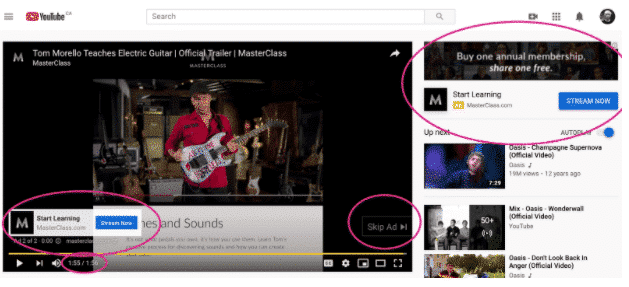
#
Non-skippable in-stream video ads #
Because 76% of people report that they automatically skip ads, it’s also very beneficial to run pre-roll or mid-roll ads that don’t have a skip button at all.
When should you do this? When you’re aiming for a wide lift in awareness (I.e., Camp Campaigns, Weekend Classes, APL/SPL, etc) and you’re confident that your creative is strong enough to hold your audience’s attention for the full 15 seconds.
Note that with non-skippable ads, companies pay per impression, at CPM (i.e., per 1,000 views).
Bumper ads #
At 6 seconds long, bumper ads are a snappy type of non-skippable in-stream ad. They’re the same in that you pay for impressions, they show up as pre-, mid- or post-roll, and they’re generally best used for reach and awareness campaigns.
#
#
Discovery Ads #
Whereas in-stream ads function something like a traditional TV advert, discovery ads are more akin to the ads you see on Google’s search results page. (This makes sense when we remember that YouTube is as much a search engine as a social media platform.)
Discovery ads show up alongside organic search results. So, if our video looks more relevant than the organic results, people can choose to watch it, instead.
Discovery ads include three lines of text along with a thumbnail. When interested people click on the ad, they’re sent through to our video page or YouTube channel.
(Discovery ads are also a type of TrueView ad, because people must actively choose to watch them. For example, Home Depot Canada has a series of 30-second discovery ads that surface when users type in relevant search terms:
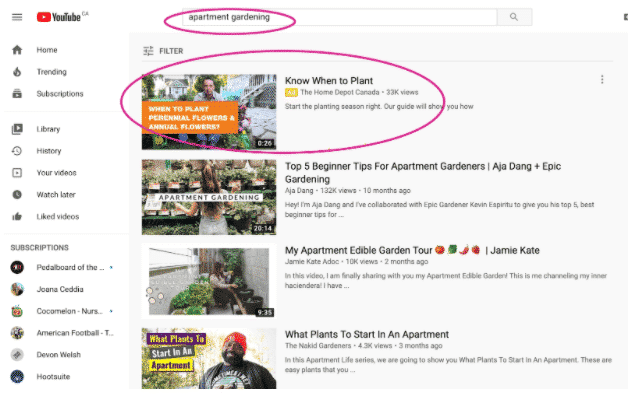
Non-Video Ads #
For when we may not have a budget for video, YouTube offers non-video ads.
- Display ads: appear on the right-hand sidebar, and include an image and text, alongside a CTA with a link to your website.
- In-video overlay ads: appear floating on top of video content from monetized YouTube channels.
In a perfect world, both ad types appear in conjunction with related content. However, that’s not always the case.
For example, this “osteopath’s helpful shoulder exercise” video probably falls generally under “health” and perhaps so do these ads for herbal remedies and MRIs. Of course, the chances of a viewer being interested in all three are slim. This is a great argument for being picky about your audience targeting—which I’ll cover below.
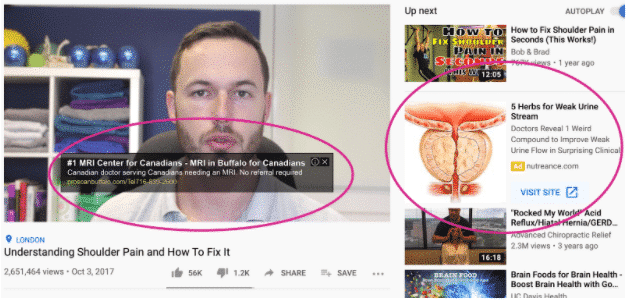
How to Advertise on YouTube: #
Here’s where we get to work on advertising. First, your video ad will live on YouTube, so start by uploading the video file to your YouTube channel. Make sure the video is public—or, if you don’t want it popping up in the S4K channel, you can make it unlisted.
(For those that may not know how to go about uploading YouTube content, use this link: https://support.google.com/youtube/answer/57407?hl=en-GB&co=GENIE.Platform%3DDesktop#zippy= to find a tutorial that goes through the whole process).
Create the Campaign #
Choose the Campaign Goal, based on your marketing objective for S4K.
- Sales
- Leads
- Website Traffic
- Product and Brand Consideration
- Brand Awareness and Reach
(TIP: In most cases, the goal for S4K will be one of the following: Website Traffic, Brand Awareness/Reach and Product/Brand Consideration)
Select your campaign type. These include all forms of Google ads (including search results, text, shopping) so make sure you select Video or, in some cases, Discovery campaigns to show your video to audiences on YouTube.
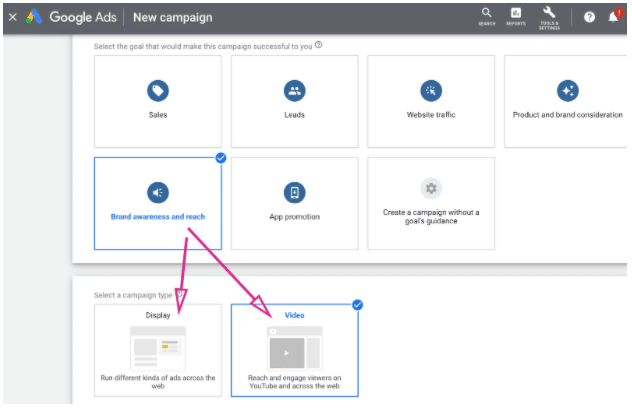
(TIP: Display ads can also be surfaced on YouTube, but remember that they aren’t videos, they’re just text and a thumbnail, and they also show up across Google’s Display network.)
Since you’re likely working with video, you’ll want to select your video campaign subtype:

(TIP: also, don’t forget to name your campaign in a way that’s easy to locate and edit in the future. We don’t want any lost campaigns!)
Define the Campaign Parameters #
- Select your bid strategy (for the most part, the campaign type will determine this: do you want conversions, clicks, or impressions?) for help deciding a bid strategy, you can take a quick look at this link: https://support.google.com/google-ads/answer/2472725?hl=en&ref_topic=3119128
- Enter your budget by day or as the total amount you’re willing to spend on the campaign. Also enter the dates your ad will run.
- Select where your ads will show up:
- Discovery only (i.e., YouTube search results);
- All of YouTube (i.e., search results, but also channel pages, videos and the YouTube homepage)
- YouTube Display network (i.e., non-YouTube affiliate websites, etc.)
- Select your audience’s language, and location. As we only operate in the UK, you should set this to English and set the location to the area that the campaign is advertising for (I.e., Fullbrook Camps should be centred to people who are local to West Byfleet, etc)
- Choose how “sensitive” your brand safety guidelines are. In other words: how much profanity, violence or suggestive content are you willing to have your ads run alongside? More sensitive brands will have their ads running in a smaller pool of videos, which may drive up the price you pay. (TIP: I’d recommend “standard inventory” in most cases, because we can maximize reach this way, without risking our adverts on any over sensitive content. If we need to be safe though, selecting “Limited Inventory” is the best bet.)
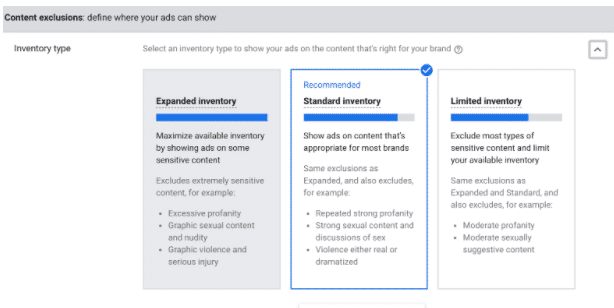
Target the Audience #
- Demographics: This covers age, gender, parental status, and household income. But YouTube also offers more detailed life-stage data: you can target new homeowners, college students, new parents, for instance
-
- In our case, for example, we would want to target adults aged 25+ who are parents, perhaps “New Parents” (considering that we run weekend classes from children being 18 Months old).
-
- Interests: use topics and keywords to target people based on their past behaviour (i.e., search topics). This is how YouTube helps you find people at crucial moments
-
- in our example, when parents are searching for a holiday club that their child can go to, or a weekend class to practice their passion for sports, etc.
-
(PRODUCTION TIP: Whether a video is relevant to a user’s interests is 3x more important to people than if it has a relevant celebrity in it, and 1.6x more important than if it looks like it was expensive to produce).
- Remarketing: Target audiences who have already interacted with your other videos, your website or your app.
-
- We have many audiences that have downloaded our app and/or have a child of their own attending one of our services. Remarketing can prove very useful because of that fact.
-
Set Campaign to Live #
Enter the link to your ad and hit the Create Campaign button to set your campaign running.
For more detail, YouTube has its own ‘Guidelines for ad creation’ here: https://support.google.com/google-ads/answer/2375497?hl=en&ref_topic=3119118
(TIP: This is also the place to go if you want to get ambitious and start experimenting with ad sequence campaigns, where you can upload multiple types of ads that support each other and are arranged to surface to your audience in the right order.)
YouTube Advertising Specifications: #
Skippable and non-skippable in-stream video ads on YouTube must first be uploaded as regular YouTube videos. So, for the most part your video ad’s technical specs (file size, dimensions, image sizes, etc) will be the same as for any YouTube video. Once it’s uploaded to your channel, you’re free to use it as a campaign.
The exception Is Discovery Ads, which follow a different set of rules here:
YouTube ad specs (for Discovery ads):
- File format: AVI, ASF, Quicktime, Windows Media, MP4 or MPEG.
- Video Codec: H.264, MPEG-2 or MPEG-4
- Audio Codec: AAC-LC or MP3
- Aspect Ratio: 16: 9 or 4: 3 is recommended, but YouTube will auto adjust the file anyway, depending on the aspect ratio and device.
- Frame Rate: 30 FPS
- Maximum File Size: 1GB For Discovery Ads
YouTube Video Campaign length guidelines:
Minimum Length:
- Skippable Ads: 12 Seconds
Maximum Length:
- Skippable Ads: 3 minutes
- Non-Skippable Ads: 15 Seconds
- Bumper Ads: 6 Seconds
Pro Tips: #
Adding a Call to Action (CTA) #
As I’ve mentioned, your YouTube ad needs a goal for you to measure its success.
If your campaign goals are lower-funnel actions (e.g., clicks, sales, conversions, or traffic) then set the ad up as a TrueView for action campaign. This will give additional clickable elements to your ad, so viewers can click before the end.
For instance, Monday.com have CTA overlays and companion banners galore.
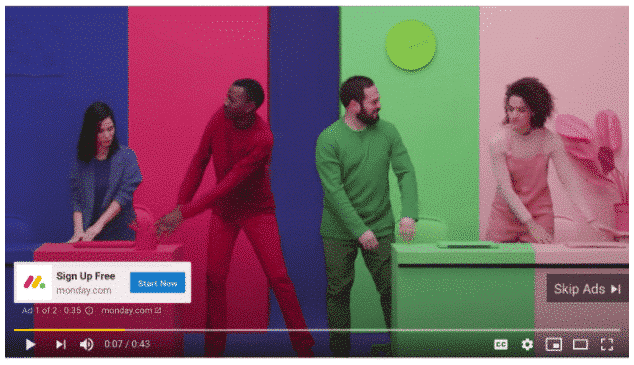

Building Trust and Credibility #
YouTube is the most trusted social media platform for finding and purchasing products. If you’re looking to build credibility around your brand, YouTube is a great place to go.
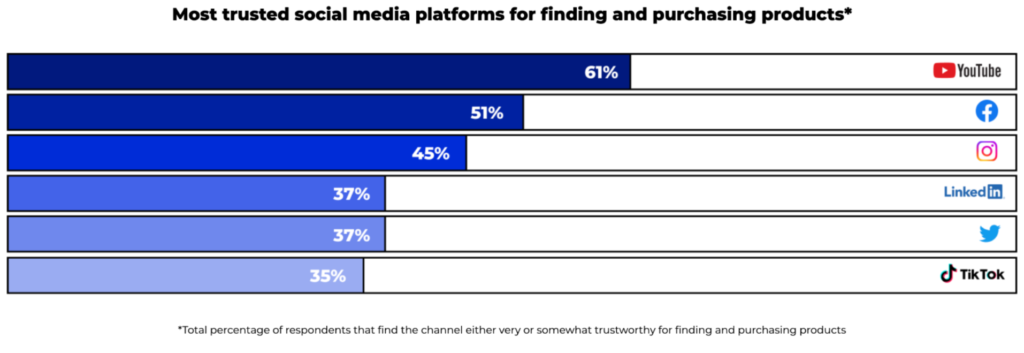
Video testimonials, brand storytelling, visual tutorials, hands-on reviews and live demos are just a few ways you can shed light on how Sport4Kids is beneficial in various ways. Partnering with creators in your niche can also help you build trust with potential customers.
YouTube SEO #
YouTube SEO is an overlooked aspect of video marketing on the platform. But it’s crucial for showing up at the right time. Otherwise, our videos won’t be watched.
Optimizing your videos starts at the beginning of the video creation process — during ideation. Conduct keyword research to find the right topics and angles for your videos. Then, optimize the following elements when publishing on YouTube to maximize visibility:
- Titles and descriptions: Use primary and secondary keywords naturally.
- Thumbnails: Browse top videos and identify which thumbnails perform well for a particular keyword. Thumbnails with faces, expressions and text often stand out from others and drive more clicks.
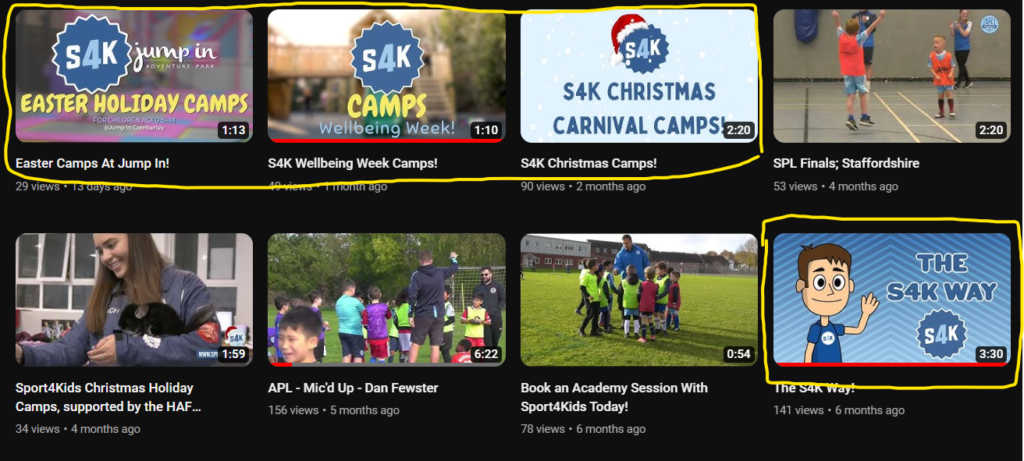
- Tags: Add relevant words and phrases to tell both YouTube and viewers what your video is about. While tags are less important than they used to be, they can still impact your search.
YouTube’s algorithm also favours videos that see more engagement. Promote your videos on other platforms like social media and forums to get more views and give it a push.
Also, link to your video from other videos on your channel using cards and end screens. Lastly, don’t hesitate to ask people for likes, comments and social follows. You’ll be surprised at how effective proactively reaching out can be.
YouTube Shorts Marketing #
YouTube Shorts are like Instagram Reels or TikTok videos. YouTube Shorts are 60 seconds videos that can be watched on YouTube. Creators usually pick up a social media trend and use it in these videos to reach more audiences. These short videos can also help you create more content as compared to a full-fledged long video.
This video format also has video enhancing features like music overlays to give your content an appealing feel.
- YouTube Shorts help you reach a wider audience
-
- As mentioned before, YouTube Shorts are best for creating videos on ongoing social media trends. These videos help you reach a wider audience base. Additionally, because these videos are short, they also help you grab the attention of the audience better.
-
- It helps you repurpose content
-
- Some channels already have a lot of video content but the content, for some reason, has not reached the desired audience. With YouTube Shorts, you can repurpose the content effectively. Suppose you have a campaign running for a weekend class that’s just a bit too lengthy, or a Mic’d Up video of a coach that has key entertaining scenes. Using shorts, you can grab all the key elements of the video campaign and make a short, snappy version for shorts viewers. As for the Mic’d Up video, you can pinch the best moments easily, and make a short video read for your viewers to see.
-
- Helps you keep your audience updated
-
- YouTube shorts Is great for short updates on various topics. Do we have a new venue? Show our audience using Shorts! Have we made a new partner with another company? Share the good news using YouTube Shorts, etc!
-
#
#
YouTube Monetization #
YouTube can boost our existing marketing strategy, but it can also become an additional revenue stream on its own for Sport4Kids
Channels that meet YouTube Partner Program’s eligibility criteria can monetize their videos and make money based on the number of views and engagement. This allows other businesses to put adverts onto our videos, and we would make revenue based on how many people are clicking/staying on that ad.
YouTube Marketing Benefits #
Here are a few benefits to utilising YouTube Marketing, for Sport4Kids Marketing as a whole.
- Posting on YouTube helps us to appear more in searches
-
- When we get to use YouTube for marketing S4K regularly, we will enhance our chances of appearing in web search results. As a company, it’s important to strive to maximise our Internet visibility to the greatest extent possible. Google favours businesses that utilise its tools and may increase the search engine ranking of businesses that engage with YouTube.
-
- Videos have overall increased Conversion Rates
-
- Keep in mind that YouTube is just becoming bigger. Annually, more and more individuals devote more time to it. Unlike other sites, YouTube has a very diverse audience. People of different ages, educational backgrounds, and economic levels from all over the world use the platform. They use the service for a variety of purposes, including education and entertainment. Regardless of what Sport4Kids is attempting to market or what our objectives are, there’s a good chance that we may will accomplish them through YouTube.
-

 Cricket Classes
Cricket Classes Dance Classes
Dance Classes Family Events
Family Events Football Academy
Football Academy Football Classes
Football Classes Football Tournaments
Football Tournaments Golf Classes
Golf Classes Holiday Camps
Holiday Camps  Rugby Classes
Rugby Classes Tennis Classes
Tennis Classes